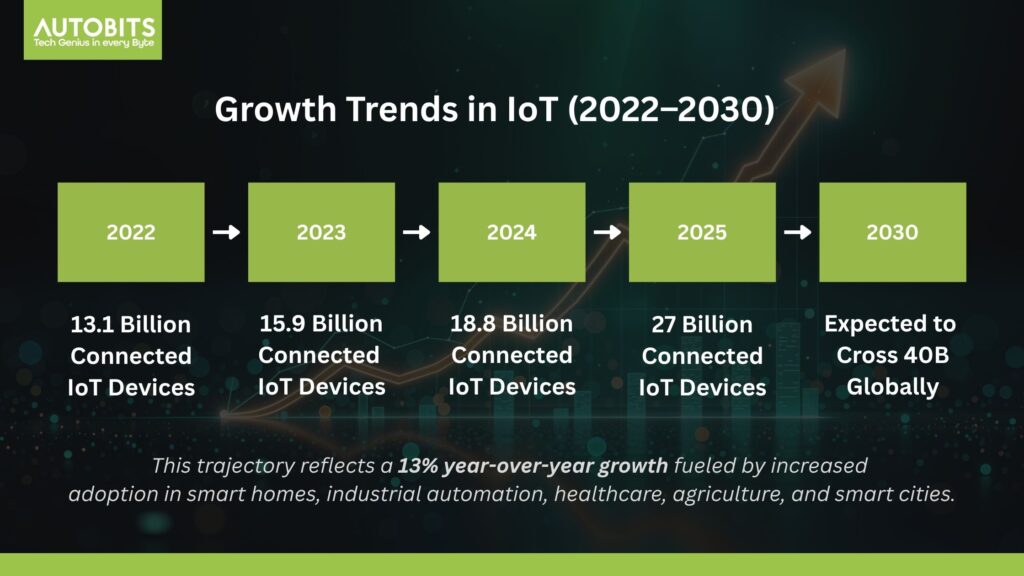The Internet of Things (IoT) transforms how we engage with technology in the 21st century. The impressive growth and adoption of IoT devices suggest a shift in how we think about connected devices and their uses in different industries. Global projections estimate that connected devices will exceed 27 billion by 2025. These devices have tremendously impacted our society, from smart speakers in our homes to industrial sensors in the workplace. This information-rich aspect of IoT allows devices to communicate and collate in systems, continuously making decisions on our behalf.
What is essential to understand is how many IoT devices there will be on the market by 2025 and what affects the numbers of those devices. Let’s take a closer look at some research and projections.

IoT Devices Count in 2025: The Real Numbers
According to one of the most reputable sites for industry data, IoT Analytics, there will be approximately 27.1 billion connected IoT devices worldwide by 2025. The projection was slightly adjusted downward due to uncertainties in the global economy, semiconductor shortages, and the effects of geopolitical uncertainties, but it still projects strong growth.
Breakdown by Source:
- IoT Analytics (2025): ~27.1 billion connected IoT devices
- Statista (2030 projection): 32.1 billion IoT devices
- TechJury & IHS Markit: Up to 75 billion (widely debated and often includes inactive or non-standard devices)
Key Insight: The 27 billion mark is considered the most realistic and reliable forecast for 2025 by industry consensus.
Growth Trends in IoT (2022–2030)

- 2022: 13.1 billion connected IoT devices
- 2023: 15.9 billion
- 2024: ~18.8 billion
- 2025: ~27 billion
- 2030: Expected to cross 40 billion globally
This trajectory reflects a 13% year-over-year growth fueled by increased adoption in smart homes, industrial automation, healthcare, agriculture, and smart cities.
Industry-wise Distribution of IoT Devices
IoT is no longer limited to home automation. Here’s how IoT devices are distributed across industries:
| Sector | Share of IoT Devices |
| Consumer Electronics | ~60% |
| Industrial/Manufacturing | ~20% |
| Healthcare | ~8% |
| Smart Cities & Infrastructure | ~7% |
| Logistics & Supply Chain | ~5 |
The consumer segment dominates, primarily due to the rising number of smart homes, wearables, and personal IoT gadgets like smart speakers and home assistants.
Why the Numbers Vary: Understanding Definitions
The number of IoT devices often varies across reports. Here’s why:
1. Definitions Differ
- Some counts comprise active internet-connected devices only; some counts include not only sensors that are installed but not deployed to legacy equipment or devices under development.
2. Scope of Inclusion
- Broader estimates include all embedded systems, for example, any sensor in manufacturing or agriculture, as they are not always internet-enabled.
3. Market Conditions
- Global supply chain disruptions and chip shortages have also delayed many IoT rollouts in some areas.
- Political conflicts and changes in regulations (including data privacy regulations) are also influencing adoption rates.
Global Adoption of IoT Devices by Region
According to Cisco and Statista, IoT device ownership varies significantly by region:
| Region | Devices per Person (2023) |
| North America | 13.4 |
| Western Europe | 9.4 |
| Asia-Pacific | 5.1 |
| Latin America | 3.1 |
| Africa & Middle East | 1.5 |
Greater China alone accounts for over 5 billion IoT devices—a sign of its booming industrial IoT sector.
IoT Connectivity: The Backbone
Six primary wireless technologies power IoT devices:
- LPWAN (Low-Power Wide Area Networks): For long-range, low-power use.
- Cellular (3G/4G/5G): Great coverage but power-intensive.
- Bluetooth/BLE: Used in wearables and smart home devices.
- Wi-Fi: Common in consumer electronics.
- Zigbee/Mesh: Ideal for home automation and short-range comms.
- RFID: Used in logistics, retail, and inventory tracking.
The growing adoption of 5G and satellite-based LPWAN is expected to expand IoT capabilities over the next few years dramatically.
Consumer Trends and Adoption Challenges
Positive Trends:
- On average, U.S. households had 22 connected devices in 2022.
- 62% of smart speaker users now have more than one device.
- Edge AI is becoming standard as it allows users to process data in real-time.
Challenges:
- 24% of consumers feel overwhelmed by the above individual devices they must manage.
- Security and privacy concerns are essential impediments to broader adoption.
Internet of Things (IoT) Devices: Future Outlook
By 2030:
- 40 billion IoT devices are anticipated worldwide.
- 79.4 zettabytes of data from the IoT.
- IoT spending is expected to exceed $1.6 trillion.
- There will be smarter and connected smart homes, factories, vehicles, and cities.
Autobits Labs: Powering the Future of Industry 4.0
With the number of IoT devices expected to skyrocket in 2025, organizations must recognize the importance of intelligent applications in staying ahead. Autobits Labs is leading the charge in addressing this critical need by delivering comprehensive Industry 4.0 solutions, enabling manufacturers to improve productivity, minimize machine downtime, and make real-time data-driven decisions.
Autobits Labs develops a range of applications aimed at advancing industries around the world. From CNC machine monitoring platforms to energy monitoring systems and predictive maintenance applications to intelligent IoT gateways, Autobits Labs enables industries to readily explore insights gained with data collection and bring them into actionable solutions that seamlessly integrate to optimize production.
Whether you are in manufacturing, automotive, aerospace, or any other industrial industry, our innovative and intelligent solutions are developed to help optimize our operations, providing new ways to increase productivity and secure sustainable operations as the world becomes more connected.
Are you ready to modernize your factory with Industry 4.0? Book a Free Demo today and see why Autobits Labs is the right choice to advance manufacturing.
Conclusion
Global adoption of the Internet of Things (IoT) devices will reach around 27 billion in 2025, and this will be hailed as one of the most impactful tech transformations in modern history. Although forecasts have varied wildly, the trajectory is clear. IoT is omnipresent in our lives, from our homes and vehicles to industrial factories, & as it streamlines operations, stimulates productivity, saves energy, makes the world safer, and improves experiences for consumers.
We will see IoT devices become a much bigger part of our lives by 2030.
Frequently Asked Questions (FAQs) About Internet of Things (IoT)
What is an IoT Device?
An IoT (Internet of Things) device is defined as any physical object capable of connecting to the Internet and collecting data, exchanging data, or generally exchanging information. Some common examples of IoT devices include smart thermostats, fitness trackers, industrial sensors, and smart connected cars.
How many IoT devices will be there in 2025?
In 2025, there are expected to be approximately 27.1 billion IoT devices in the world (IoT Analytics).
Why do estimates of IoT Devices vary?
Estimates of total IoT devices vary by source due to different definitions of what comprises an IoT device. Some sources include non-active or installed IoT devices, while others may only count devices that are actively connected.
What industries most utilize IoT?
IoT is utilized and intersects with the following:
– Consumer electronics (smart homes)
– Industrial automation
– Healthcare (remote monitoring)
– Logistics (Asset tracking)
– Smart cities (Traffic, lighting, utilities)
What technologies are utilized for IoT?
The primary IoT connectivity technologies are:
– LPWAN
– Bluetooth/BLE
– Zigbee
– Wi-Fi
– Cellular (3G/4G/5G)
– RFID
What is the future of IoT?
By the year 2030, more than 40 billion IoT devices are expected and are likely to expand due to advancements in 5G, Edge AI, and satellite connectivity.

![How Many IoT Devices Are There in 2025 [All You Need To Know]](https://autobitslabs.com/wp-content/uploads/2025/06/How-Many-IoT-Devices-Are-There-in-2025-All-You-Need-To-Know.jpg)



